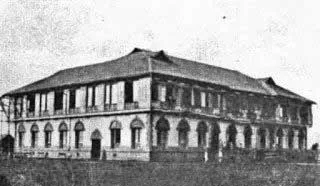The Bureau of Education Setup in Batangas in 1906
[In this article: Batangas Province, education in Batangas, Bureau of Education, American colonial era, policy of benevolent assimilation, farm schools, primary education, intermediate education, secondary education]
The year 1906 was just four years after the end of the Philippine-American War, something brought about for all intents and purposes by the surrender of General Miguel Malvar in April of 1902. But even while the war was raging, the American colonial government had already started to put in place mechanisms that would put into place its policy of “benevolent assimilation,” i.e. one intended “to win the confidence, respect, and affection of the inhabitants of the Philippines by assuring them in every possible way that full measure of individual rights and liberties which is the heritage of free peoples1.”
One of these mechanisms was education, one which allowed the Americans “to spread their cultural values, particularly the English language, to the Filipino people2.” By 1900, the Americans had already put in place an educational bureaucracy; and in Batangas, a single division3 had been created for the provinces of Batangas, Cavite and Tayabas. The Superintendent for the Division was on M.A. Colton4.
By 1906, with relative peace having been restored for a few years already, enough schools had been built and teaching personnel for the three provinces to merit their own respective education divisions. For Batangas, the Superintendent was Hammon H. Buck, originally from the state of Arkansas in the United States5.
 |
| A school building in Batangas town early during the American colonial era. Image from the public domain publication "A Tribute of Love to the Memory of Anna \Elizabeth Hahn." |
The division headquarters was in the then-town of Batangas. Buck was assisted in the performance of his duties by one Manuel Macatangay, hired as his clerk6.
The Division of Batangas was broken up into several districts, each with a Supervising Teacher, as shown in the table below:
|
DISTRICT Balayan Batangas Town Bauan Calaca Cuenca Ibaan Lipa Lobo Nasugbu Rosario San Jose San Juan Taal Tanauan (and Sto. Tomas) |
SUPERVISING TEACHER B. K. Daniels E. H. Hammond Samuel T. Houston Tomas Cabrera Braulio Bejasa Manuel Agregado Ulysses S. Andes Felipe Contreras Marshall N. Johnson Enrique Halili Perfecto Condes Lorenzo K. Bautista Russell Trace Charles A. Weise |
The opening of “lower education” – i.e. elementary, intermediate and secondary levels – schools had been a primary goal of the Bureau of Education in the early years of the American colonial era7. Hence, presumably, there would have been at least one primary school in each of the towns regarded as an educational district.
There were three intermediate schools8 in the province, and these were in Bauan, Lipa and Taal. The one in Bauan was under one Mrs. Edith P. Houston, possibly related to Bauan’s Supervising Teacher Samuel T. Houston. In Lipa, assigned to the intermediate school were Clarence E. Ferguson, Mrs. Ina L. Ferguson and Hugo La Torre. Finally, the school in Taal had Arthur N. Small as Principal with Mrs. Helen Trace and Ward B. Gregg presumably as teachers.
At this time, a provincial high school had already been opened in the town of Batangas. Its Principal was one H. C. Theobald, while presumably its teachers were Frances Gray, Adele Clare Clagett, Anna E. Hahn, Norine Larimer, Teresa Solis, Charles H. T. Townsend and Meyer Scheer.
The division also operated in the town of Batangas a “farm school” with George Whiting and William F. Vain presumably as teachers. Such a school was presumably one which pupils attended to learn farming methods which they could, in turn, use in their own lands.
This farm school in Batangas was on a 3-hectare property, 2.5 hectares of which were used for cultivation. By 1913, the same school 50 pupils in Grade 5, 31 in Grade 6 and 8 in Grade 7 for a total of 89. The school had for its use one farm animal9.
2 “In our image: America's empire in the Philippines,” by Stanley Karnow, published 1989 in the United States, as quoted in Wikipedia.
3 “The Present Educational Movement in the Philippine Islands,” an excerpt from “Report of the Commissioner of Education, United States Bureau of Education,” published 1902 in Washington D.C.
5 “Tagaytay: Town on the Ridge,” by V. Elizabeth Reyes, published 1996 in the Philippines.
6 Most of the information about the Bureau of Education structure in Batangas taken from “Bulletin of the Bureau of Education,” published 1906 by the Bureau of Education, Philippines.
7 “The Present Educational Movement in the Philippine Islands,” op cit.
8 Depending on a country’s school system, the intermediate years or “middle school” was the bridge between primary school and secondary school. “Middle school,” Wikipedia.
9 “13th Annual Report of the Director of Education,” published 1913 by the Bureau of Printing, Manila.
